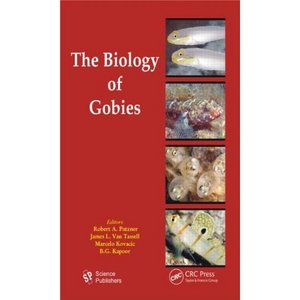Gobies on coral reefs
Herler, Juergen, Munday, Philip L., and Hernaman, Vanessa (2011) Gobies on coral reefs. In: Patzner, Robert A., Van Tassel, James L., Kovacic, Marcelo, and Kapoor, B.G., (eds.) The Biology of Gobies. Science Publishers, Boca Raton, FL, pp. 493-529.
![[img]](https://researchonline.jcu.edu.au/5176/4.hassmallThumbnailVersion/5176_Herler_et_al_2011_Book_Cover.jpg)
|
Image (JPEG) (Book Cover)
- Cover Image
Download (27kB) |
|
|
PDF (Accepted Version)
Restricted to Repository staff only |
||
|
PDF (Published Version)
- Published Version
Restricted to Repository staff only |
Abstract
[Extract] The family Gobiidae comprises at least 2000 species (Nelson, 2006), with many still undiscovered or undescribed. More than half of all goby species are found on coral reefs and thus they contribute greatly to the astonishing fish diversity of this environment. Most coral reef gobies are closely associated with the substratum, where they seek shelter from predators in the complex physical structure of reef habitat (Munday and Jones, 1998). As a consequence of their small size and cryptic life-style, careful investigations by trained experts are necessary to reveal their full diversity. Although there are few such researchers, new species are still being described discovered (e.g., Coryphopterus (Victor, 2007), Eviota (Gill and Jewett, 2004), Gobiodon (Harold and Winterbottom, 1995; Harold and Winterbottom, 1999; Winterbottom and Harold, 2005), Priolepis (Nogawa and Endo, 2007) and Trimma (e.g. Winterbottom, 2004, 2006; Hagiwara and Winterbottom, 2007; Suzuki and Senou, 2007; Winterbottom and Zur, 2007). Despite the diversity of coral reef gobies – the genus Trimma, for example, may include nearly 100 species (Winterbottom and Southcott, 2008) – most species are easily overlooked and are commonly excluded from sampling or ecological surveys. However, a recent upsurge of interest in the ecological role of small reef fishes (e.g., Munday and Jones, 1998; Depczynski and Bellwood, 2003) and the use of several coral-reef goby genera as model groups in ecology and evolution (e.g., Forrester and Steele, 2000; Munday et al., 2001; Taylor and Hellberg, 2003; Munday, 2004b) has greatly increased our understanding of the biology and ecology of this diverse and interesting group of coral reef fishes.
In this chapter we examine the ecology, life-histories and reproductive behaviour of coral reef gobies. We also explore morphological adaptations that are associated with the unique life-styles exhibited by many coral reef gobies, and the extreme miniaturization of certain groups of species. Although frequently overlooked in studies of reef fish assemblages due to their small size and cryptic behaviour, we show that gobies play an important role in coral reef ecoystems, and that they have proven to be a useful model group for studying a broad range of topics in ecology and evolution, including: species diversification, ecological and morphological adaptation, the evolution of animal life history traits, mechanisms of community structure and population regulation, and the evolution of animal behaviour.
| Item ID: | 5176 |
|---|---|
| Item Type: | Book Chapter (Research - B1) |
| ISBN: | 978-1-57808-436-4 |
| Keywords: | gobies; Gobaiidae; coral reefs |
| Related URLs: | |
| Date Deposited: | 08 Sep 2009 03:25 |
| FoR Codes: | 06 BIOLOGICAL SCIENCES > 0602 Ecology > 060205 Marine and Estuarine Ecology (incl Marine Ichthyology) @ 100% |
| SEO Codes: | 97 EXPANDING KNOWLEDGE > 970106 Expanding Knowledge in the Biological Sciences @ 100% |
| Downloads: |
Total: 524 Last 12 Months: 2 |
| More Statistics |



